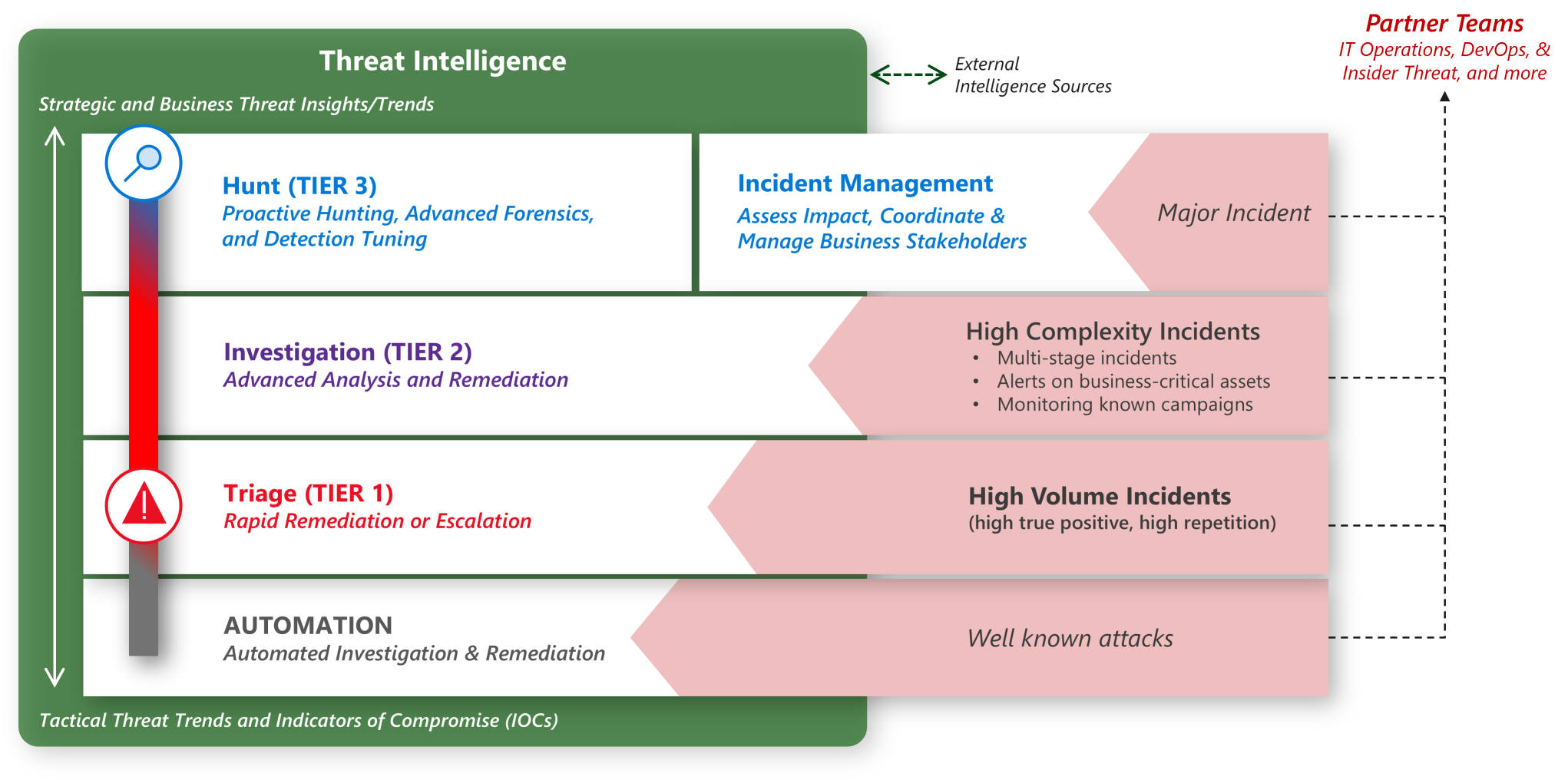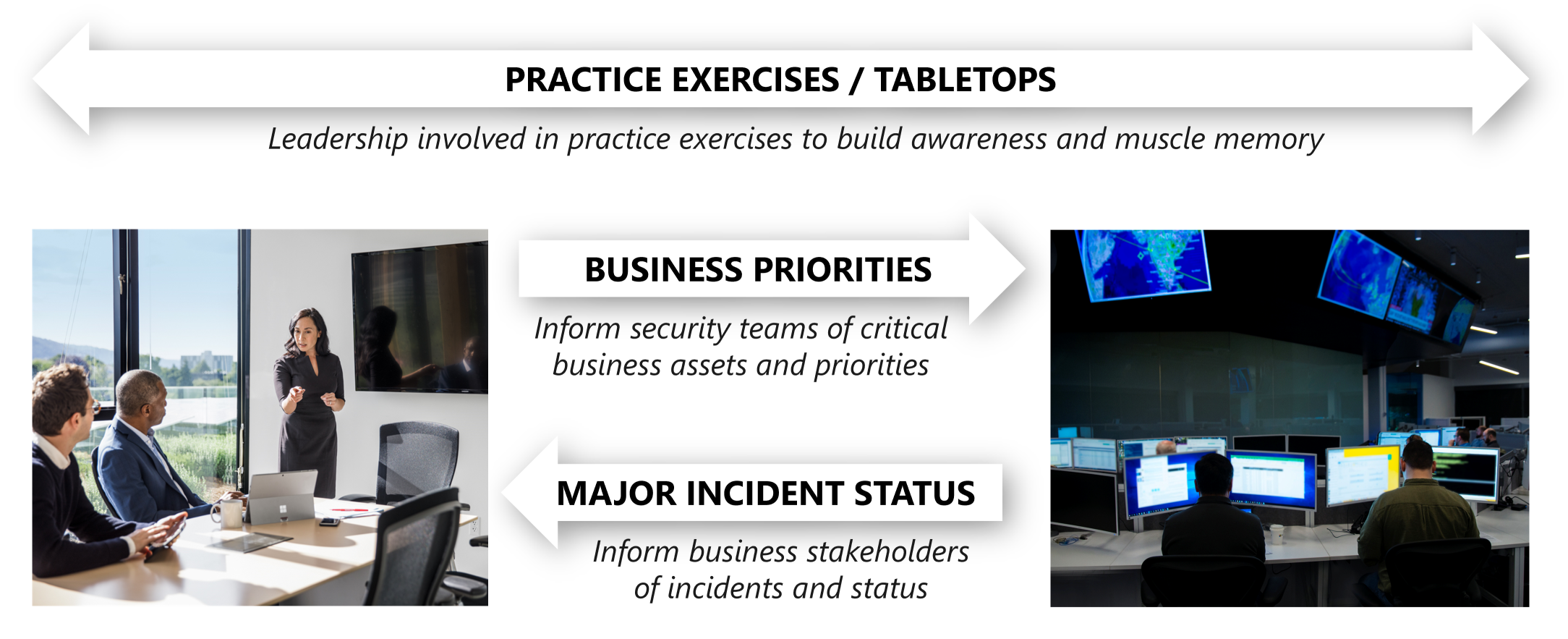Security operations
This article provides strategic guidance for leaders establishing or modernizing a security operation function. For architecture and technology focused best practices, see Best practices for security operations.
Security operations reduce risk by limiting damage from attackers who gain access to your organization's resources. Security operations focus on reducing the time attackers have access to resources by detecting, responding to, and helping recover from active attacks.
Rapid response and recovery protect your organization by damaging the adversary's return on investment (ROI). When adversaries are evicted and forced to start a new attack, their cost to attack your organization goes up.
Security operations (SecOps) is sometimes referred to or structured as a security operations center (SOC). Security posture management of the operational environment is a function of governance discipline. Security of the DevOps process is part of the innovation security discipline.
Watch the following video to learn more about SecOps and its critical role in reducing risk for your organization.
People and process
Security operations can be highly technical, but more importantly, it's a human discipline. People are the most valuable asset in security operations. Their experience, skill, insight, creativity, and resourcefulness are what make the discipline effective.
Attacks on your organization are also planned and conducted by people like criminals, spies, and hacktivists. While some commodity attacks are fully automated, the most damaging ones are often done by live human attack operators.
Focus on empowering people: your goal shouldn't be to replace people with automation. Empower your people with tools that simplify their daily workflows. These tools enable them to keep up with or get ahead of the human adversaries they face.
Rapidly sorting out signal (real detections) from the noise (false positives) requires investing in both humans and automation. Automation and technology can reduce human work, but attackers are human and human judgment is critical in defeating them.
Diversify your thinking portfolio: security operations can be highly technical, but it's also just another new version of forensic investigation that shows up in many career fields like criminal justice. Don't be afraid to hire people with a strong competency in investigation or deductive or inductive reasons and train them on technology.
Make sure that your people are set up with a healthy culture and are measuring the right outcomes. These practices can increase productivity and employee enjoyment of their jobs.
SecOps culture
Key cultural elements to focus on include:
- Mission alignment: Because of how challenging this work is, security operations should always have a clear understanding of how their work connects to the overall organization's mission and goals.
- Continuous learning: Security operations are highly detailed work and always changing because attackers are creative and persistent. It's critical to continuously learn and work to automate highly repetitive or highly manual tasks. These types of tasks can quickly wear down morale and team effectiveness. Ensure that the culture rewards learning, finding, and fixing these pain points.
- Teamwork: We've learned that the "lone hero" doesn't work in security operations. Nobody is as smart as the whole team together. Teamwork also makes a high-pressure working environment more enjoyable and productive. It's important that everyone has each other's back. Share insights, coordinate and check each other's work, and constantly learn from each other.
SecOps metrics
Metrics drive behavior, so measuring success is a critical element to get right. Metrics translate culture into clear measurable goals that drive outcomes.
We've learned that it's critical to consider what you measure, and the ways that you focus on and enforce those metrics. Recognize that security operations must manage significant variables that are out of their direct control, like attacks and attackers. Any deviations from targets should be viewed primarily as a learning opportunity for process or tool improvement, rather than assumed to be a failure by the SOC to meet a goal.
The main metrics to focus on that have a direct influence on organizational risk are:
- Mean time to acknowledge (MTTA): Responsiveness is one of the few elements SecOps has more direct control over. Measure the time between an alert, like when the light starts to blink, and when an analyst sees that alert and begins the investigation. Improving this responsiveness requires that analysts don't waste time investigating false positives. It can be achieved with ruthless prioritization, ensuring that any alert feed that requires an analyst response must have a track record of 90 percent true positive detections.
- Mean time to remediate (MTTR): Effectiveness of reducing risk measures the next period of time. That period is the time the analyst begins the investigation to when the incident is remediated. MTTR identifies how long it takes SecOps to remove the attacker's access from the environment. This information helps identify where to invest in processes and tools to help analysts reduce risk.
- Incidents remediated (manually or with automation): Measuring how many incidents are remediated manually and how many are resolved with automation is another key way to inform staffing and tool decisions.
- Escalations between each tier: Track how many incidents escalated between tiers. It helps ensure accurate tracking of the workload to inform staffing and other decisions. For example, so that work done on escalated incidents isn't attributed to the wrong team.
Security operations model
Security operations handles a combination of high volume incidents and high complexity incidents.
Security operations teams often focus on three key outcomes:
- Incident management: Manage active attacks on the environment, including:
- Reactively responding to detected attacks.
- Proactively hunting for attacks that slipped through traditional threat detections.
- Coordinating the legal, communications, and other business implications of security incidents.
- Incident preparation: Help the organization prepare for future attacks. Incident preparation is a broader strategic set of activities that are aimed at building muscle memory and context at all levels of the organization. This strategy prepares people to better handle major attacks and gain insights on security process improvements.
- Threat intelligence: Gathering, processing, and disseminating threat intelligence to security operations, security teams, security leadership, and business leadership stakeholders through security leadership.
To deliver against these outcomes, security operations teams should be structured to focus on key outcomes. In larger SecOps teams, the outcomes are often broken out between subteams.
- Triage (tier 1): The first line of response for security incidents. Triage is focused on the high-volume processing of alerts, and typically generated by automation and tools. The triage processes solve for most of common incident types and resolve them within the team. More complex incidents, or incidents that haven't been seen and resolved before should be escalated to tier 2.
- Investigation (tier 2): Focused on incidents that require further investigation, often requiring correlation of data points from multiple sources. This investigation tier looks to provide repeatable solutions to issues escalated to them. It then enables tier 1 to resolve later recurrences of that issue type. Tier 2 will also respond to alerts against business critical systems, to reflect the severity of the risk and the need to act quickly.
- Hunt (tier 3): Focused primarily on proactive hunting for highly sophisticated attack processes and developing guidance to the wider teams for maturing security controls as a result. The tier 3 team also acts as an escalation point for major incidents in to support forensic analysis and response.
SecOps business touchpoints
SecOps has multiple potential interactions with business leadership.
- Business context to SecOps: SecOps must understand what is most important to the organization so that the team can apply that context to fluid real-time security situations. What would have the most negative impact on the business? Downtime of critical systems? A loss of reputation and customer trust? Disclosure of sensitive data? Tampering with critical data or systems? We've learned it's critical that key leaders and staff in the SOC understand this context. They'll wade through the continuous flood of information and triage incidents and prioritize their time, attention, and effort.
- Joint practice exercises with SecOps: Business leaders should regularly join SecOps in practicing response to major incidents. This training builds the muscle memory and relationships that are critical to fast and effective decision making in the high pressure of real incidents, reducing organizational risk. This practice also reduces risk by exposing gaps and assumptions in the process that can be fixed before a real incident occurs.
- Major incidents updates from SecOps: SecOps should provide updates to business stakeholders for major incidents as they happen. This information allows business leaders to understand their risk and take both proactive and reactive steps to manage that risk. For more information on major incidents by the Microsoft Detection and Response Team, see the incident response reference guide.
- Business intelligence from the SOC: Sometimes SecOps finds that adversaries are targeting a system or data set that isn't expected. As these discoveries are made, the threat intelligence team should share these signals with business leaders as they might trigger insight for business leaders. For example, someone outside the company is aware of a secret project or unexpected attacker targets highlight the value of an otherwise overlooked dataset.
SecOps modernization
Just like other security disciplines, security operations face the transformative effect of continuously evolving business models, attackers, and technology platforms.
The transformation of security operations is driven primarily by the following trends:
- Cloud platform coverage: Security operations must detect and respond to attacks across the enterprise estate including cloud resources. Cloud resources are a new and rapidly evolving platform that is often unfamiliar to SecOps professionals.
- Shift to identity-centric security: Traditional SecOps relies heavily on network-based tools, but must now integrate identity, endpoint, application, and other tools and skills. This integration is because:
- Attackers have incorporated identity attacks, like phishing, credential theft, password spray, and other attack types into their arsenal that reliably evade network-based detections.
- Assets of value, like bring your own devices (BYOD), spend some or all of their lifecycle outside the network perimeter, limiting the utility of network detections.
- Internet of Things (IoT) and operational technology (OT) coverage: Adversaries actively target IoT and OT devices as part of their attack chains. These targets might be the ultimate purpose of an attack or a means to access or traverse the environment.
- Cloud processing of telemetry: Security operations modernization is required because of the massive increase in relevant telemetry that comes from the cloud. This telemetry is difficult or impossible to process with on-premises resources and classic techniques. It then drives SecOps to embrace cloud services that provide massive scale analytics, machine learning, and behavior analytics. These technologies help rapidly extract the value to meet the time sensitive needs of security operations.
It's important to invest in updated SecOps tools and training to ensure security operations can meet these challenges. For more information, see Update incident response processes for cloud.
For more information on security operations roles and responsibilities, see Security operations.
For more architecture and technology focused best practices, see Microsoft security best practices for security operations and the videos and slides.
Next steps
The next discipline is asset protection.



